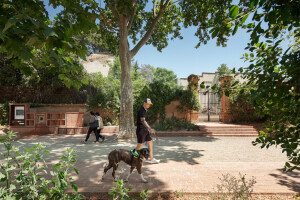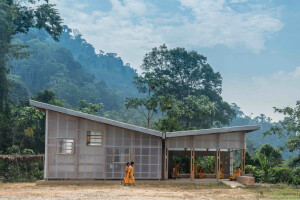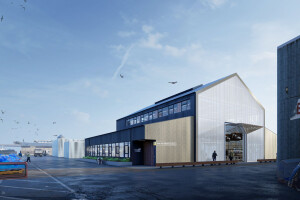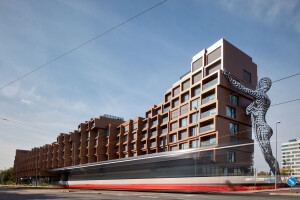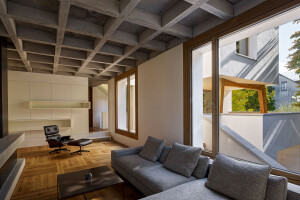The FLASH (Facilities Logistics & Support Hub) Building is a conversion of a 55,000 SF 1970’s tilt-up concrete industrial building into a synergistic environment for Facilities & Operations functions, formerly distributed throughout the Client’s 124-acre campus. Pending LEED Silver Certification, the project employs green building strategies including extensive natural light and ventilation, shading of the building exterior walls, 100% storm water capture for groundwater recharge and repurposed office furniture.
The primary organizing element is a glass walled courtyard carved out of the building center. The tree filled space provides views of the outdoors for the 145 occupants. The courtyard and 72 new skylights provide enough daylight for it to be the only light required in most spaces, most of the time. In addition operable windows and doors in the courtyard’s enclosing glass walls provide natural ventilation when preferred, given the site’s diurnal temperature range of 30 degrees, with summer highs in the 100s.
The layout has the feel of a village plan, with circulation pathways organized like a pedestrian scale street grid. All departments are accessed from this network through archways that spring from low partition walls defining “street” edges. Interior glass storefront walls enclose shared conference and lunch/break rooms that surround the courtyard. Informal meeting spaces occur in widened areas or alcoves at intersections and terminal points. The program includes open and private offices, a campus Emergency Operations Center, a carpentry shop, repair shops for instruments and equipment, a wet lab, locker rooms, shipping and receiving. Exterior components include covered truck docks, landscaped bio-swales and charging stations for a large fleet of electric carts.
The interiors are large and open, but not undifferentiated. All of the building elements including exposed utilities such as piping, air conditioning ducts and pendant lighting are used to help organize the space. The height is felt, but the composition of elements is at a human scale. Full height partitions are seldom uniform for their full height. Partitions that define the northern and southern limits of the primary open space are finished in painted gypsum board up to a height of 8 feet. Above that, metal studs are clad in translucent polycarbonate panels. This strategy provides scale to the partitions, helps the observer comprehend the larger spatial organization, and allows light from skylights to permeate adjacent spaces.
The color palette of five shades of blue and five shades of yellow work with systems furniture purchased for reuse. These colors also work with the landscaping palate, visible in the courtyard and through large portals on all sides of the building. Yellows were assigned to the north/south walls and blues were assigned to east/west walls. The varying shades of each set of colors were organized lightest to darkest. Light colors were placed on walls that contained exterior glass to minimize the contrast. Shades of color on parallel walls then progress sequentially, light to dark. Walls in the same space are typically two different shades in the progression. Perpendicular walls are chromatically complementary






















